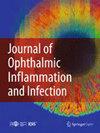法国的眼孢子虫病:布列塔尼的首例病例报告。
IF 2.3
Q1 OPHTHALMOLOGY
Journal of Ophthalmic Inflammation and Infection
Pub Date : 2024-11-06
DOI:10.1186/s12348-024-00437-7
引用次数: 0
摘要
我们报告了一例在法国居住了一年的 21 岁喀麦隆妇女的病例,她因左眼不适和瘙痒到我科就诊。检查发现,她的鼻下结膜下有一条活动的半透明线状物,因此怀疑是卢埃虫。麻醉后进行了摘除,发现了一条 31 毫米长的雄性 Loa loa。尽管微丝蚴载量较低,但阳性结果证实了诊断,而且诊断工作排除了其他部位。使用乙胺嗪治疗效果良好。该病例强调了在非流行地区考虑洛艾病的重要性,并强调了在诊断和管理中进行跨学科合作的必要性。本文章由计算机程序翻译,如有差异,请以英文原文为准。
Ocular loaiasis in France: the first case report from Brittany.
We report the case of a 21-year-old Cameroonian woman residing in France for one year, who presented to our department with left eye discomfort and itching. Examination revealed a mobile translucent cord beneath the nasal-inferior conjunctiva, prompting suspicion of loaiasis. Anesthesia was administered for extraction, revealing a 31 mm male Loa loa. A positive microfilarial load, albeit low, confirmed the diagnosis and the diagnostic workup excluded other locations. Treatment with diethylcarbamazine was well-tolerated. This case highlights the importance of considering loaiasis in non-endemic regions and underscores the need for interdisciplinary collaboration in its diagnosis and management.
求助全文
通过发布文献求助,成功后即可免费获取论文全文。
去求助
来源期刊

Journal of Ophthalmic Inflammation and Infection
OPHTHALMOLOGY-
CiteScore
3.80
自引率
3.40%
发文量
39
审稿时长
13 weeks
 求助内容:
求助内容: 应助结果提醒方式:
应助结果提醒方式:


